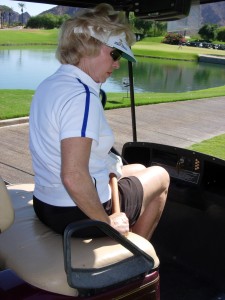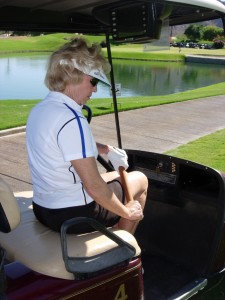by Julie Donnelly, The Pain Relief Expert
A golfer sent me a message about knee pain that was preventing him from playing for the past month. He’s excited to be planning a golf vacation to Hawaii where he can play golf on the beautiful courses that overlook the Pacific Ocean, but his knee pain is causing him a great deal of stress. There is a solution, and it’s easy to do…it’s just a matter of know where to treat and how to treat the muscles that cause knee pain.
All the advice he’s received so far has him exercising his leg (bad advice), and stretching his quadriceps (again, bad advice at this point in his healing process). Let’s discuss why exercise and stretching isn’t the best advice – yet! And what you CAN do to relieve the strain on your knee joint.
When you golf you are putting a great deal of stress on your knees. As you prepare for your shot your knees are bent, and as you swing you are especially stressing your forward knee, while you are following through with your shot. The torque puts a strain on your quadriceps, causing spasms and not only putting pressure on your knee, but actually rotating your entire pelvis which will cause sciatica, groin and hip pain. We’ll talk about them another time, but for now, let’s look at your quadriceps.
Your quadriceps all merge into the patella tendon and after crossing over your knee cap, they insert into the top of your shin bone (tibia). When your quadriceps contact you straighten your leg from the bent position, but when they are in spasm they are putting constant pressure on the tendon and you feel pain in your knee.

To release the tight muscles, even while out on the course, get a 12″x1″ length of PVC pipe and sit in a chair without arms (like a kitchen chair), or do it in your golf cart as shown in this picture. Take the pipe and bring it to the very top of your thigh, to the crease where your leg and trunk meet.
Keep the pressure at a “hurts so good” level, it shouldn’t be really painful, just a bit more than uncomfortable. Finish up with a full flush from top to bottom one more time.

Press down onto the muscle and slide (don’t roll) the pipe down to just above your knee joint. As you go down the muscles (there are four quadriceps muscles on the front of your thigh) you’ll feel painful bumps – each of them is a spasm that is putting a strain on the tendon that crosses over your knee joint.
Each spasm needs to be released and you can do that by first doing the sliding treatment around your entire thigh, from the outside to the inside, several times.
Then press the PVC pipe directly into a spasm and stay still for 30 seconds, you can also rock back and forth a little to help release the spasm.
The odds are you’ll need to repeat this several times before it totally releases. Also, I suggest you get some arnica gel (a homeopathic remedy you can get at a health food store) to put on after you do the treatment as the muscle fibers are very likely bruised and this will help them heal.
When you’re totally finished, stretch your quadriceps by bending your knee and holding your ankle. Draw your bent knee back further than your standing knee, and kick your foot out away from your butt. This will be more beneficial than just bringing your foot up to your butt and having your bent knee in front of your standing knee.
Stretching is vital for you to be flexible and have the best range-of-motion to play golf, but it’s most important to FIRST release the spasms in the muscle fibers so you can stretch safely without tearing the muscle fibers. The Secret to Your Best Golf Game EVER is an easy-to-read “how to” book for your body, and Focused Flexibility Training has a full program of self-treatments for spasms from your head to your feet, and then four stretching programs to safely stretch each muscle. You have nothing to lose by learning how to treat your muscles, and everything to gain!
Wishing you well,
Julie
P.S. Here is a great video for Knee Pain Relief
